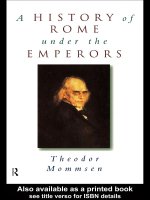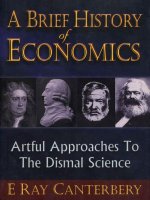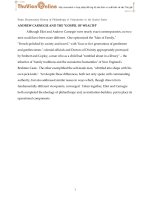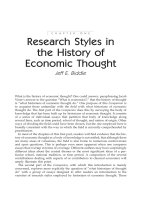THE HISTORY OF ENGLISH LAW BEFORE THE TIME OF EDWARD i
Bạn đang xem bản rút gọn của tài liệu. Xem và tải ngay bản đầy đủ của tài liệu tại đây (10.81 MB, 1,582 trang )
T H E H I S T O RY O F
E N G L I S H L AW
BEFORE THE TIME
O F E D WA R D I
L4728.indb i
3/5/10 10:15:24 AM
Sir Frederick Pollock
L4728.indb ii
Frederic William Maitland
3/5/10 10:15:25 AM
T H E H I S TO RY O F
E N G L I S H L AW
BEFORE THE TIME
O F E DWA R D I
Volume I
By Sir Frederick Pollock
and
Frederic William Maitland
Liberty Fund Indianapolis
L4728.indb iii
3/5/10 10:15:25 AM
This book is published by Liberty Fund, Inc., a foundation established to encourage
study of the ideal of a society of free and responsible individuals.
The cuneiform inscription that serves as our logo and as the design motif for
our endpapers is the earliest-known written appearance of the word “freedom”
(amagi), or “liberty.” It is taken from a clay document written about 2300 b.c. in the
Sumerian city-state of Lagash.
This is the second edition of The History of English Law before the Time of Edward I,
which was first published in 1898 by Cambridge University Press. The first edition
was published in 1895 by Cambridge University Press.
Select bibliography and notes by Professor S. F. C. Milsom, published here as an
appendix, was originally published in Cambridge University Press’s 1968 reissue
of The History of English Law before the Time of Edward I. Reprinted by permission of
Cambridge University Press.
Portrait of Sir Frederick Pollock, by Reginald Grenville Eves,
National Portrait Gallery, London
Portrait of Frederic William Maitland, by Beatrice Lock,
National Portrait Gallery, London
Printed in the United States of America
All rights reserved
c 1 2 3 4 5 6 7 8 9 10
p 1 2 3 4 5 6 7 8 9 10
Library of Congress Cataloging-in-Publication Data
Pollock, Frederick, Sir, 1845–1937.
The history of English law before the time of Edward I/by
Sir Frederick Pollock and Frederic William Maitland.—2nd ed.
p.
cm.
Originally published: 2nd ed. Cambridge: Cambridge University Press, 1898.
Includes bibliographical references and index.
isbn 978-0-86597-749-5 (hardcover: alk. paper)
isbn 978-0-86597-752-5 (pbk.: alk. paper)
1. Law—England—History. I. Maitland, Frederic William,
1850–1906. II. Title.
kd532.p64 2010
349.42—dc22
2008046535
Liberty Fund, Inc.
8335 Allison Pointe Trail, Suite 300
Indianapolis, Indiana 46250-1684
L4728.indb iv
3/5/10 10:15:27 AM
Contents
Preface to the Second Edition, xix
Preface to the First Edition, xxi
List of Abbreviations, xxiii
List of Texts Used, xxv
Additions and Corrections, xxxi
Introduction, xxxiii
Book I
Sketch of Early English Legal History
C h a p t e r I . The Dark Age in Legal History, pp. 3–28
The difficulty of beginning, 3
of Roman law, 4
Proposed retrospect, 3
The classical age
The beginnings of ecclesiastical law, 4
Decline of Roman law, 5
Third century.
Fourth century. Church and State, 5
century. The Theodosian Code, 7
The century of Justinian, 8
Laws of Euric, 8
The Lex Salica, 9
Fifth
Sixth century.
The Lex Ribuaria, and Lex
Burgundionum, 10 The Lex Romana Burgundionum, 10 The Lex Romana
Visigothorum, 10
eric, 11
Importance of The Breviary, 11
The Dionysian collection of canons, 11
Justinian and Italy, 13
L4728.indb v
Laws of Æthelbert, 14
The Edict of TheodJustinian’s books, 12
Seventh and eighth
3/5/10 10:15:27 AM
vi
C ON T E N T S
centuries. Germanic laws, 15 System of personal laws, 16 The vulgar
Roman law, 17
canon law, 19
The latent Digest, 18 The capitularies, 18 Growth of
Ninth and tenth centuries. The false Isidore, 20
The forged capitularies, 20
Church and State, 21
The darkest age, 22
Legislation in England, 23
England and the Continent, 24 Eleventh
century. The Pavian law-school, 24 The new birth of Roman law, 25
The recovered Digest, 27
The influence of Bolognese jurisprudence, 27
C h a p t e r I I . Anglo-Saxon Law, pp. 29–69
Imperfection of written records of early Germanic law, 29 Anglo-Saxon
dooms and custumals, 31
Anglo-Saxon land-books, 32
Anglo-Saxon institutions, 33
family, 35 Ranks: ceorl, eorl, gesíð, 37
39
Privileges of the clergy, 39
sion, 40
Survey of
Personal conditions: lordship, 34
Courts and justice, 42
Thegn, 37
The
Other distinctions,
Slavery and slave trade, 39 ManumisProcedure, 43
Temporal and spiritual
jurisdiction, 45 The king’s jurisdiction, 45 The Witan, 46
and hundred courts, 47 Private jurisdiction, 48
County
Subject-matter of
Anglo-Saxon justice, 48 The king’s peace, 49 Feud and atonement, 51
Wer, wíte and bót, 53 Difficulties in compelling submission to the
courts, 55
Maintenance of offenders by great men, 55
by battle, 56
Treason, 56
misadventure, 59
Homicide, 58
Personal injuries:
Archaic responsibility, 60
62
Sale and other contracts, 63
65
Land tenure, 66
Why no trial
Theft, 61
Property,
Claims for stolen goods: warranty,
Book-land, 66 Læ
´ n-land, 67
Folk-land, 67
Transition to feudalism, 69
C h a p t e r I I I . Norman Law, pp. 70–85
Obscurity of early Norman legal history, 70
French, 72
Norman law was feudal, 72
Norman law was
Feudalism in Normandy, 73
Dependent land tenure, 75 Seignorial justice, 78
79
Legal procedure, 80
Criminal law, 80
Limits of ducal power,
Ecclesiastical law, 81
The truce of God, 82 Condition of the peasantry, 82 Jurisprudence,
83
L4728.indb vi
Lanfranc of Pavia, 84
3/5/10 10:15:27 AM
C ON T E N T S
vii
C h a p t e r I V. England under the Norman Kings,
pp. 86–118
Effects of the Norman Conquest, 86
86
No mere mixture of national laws,
History of our legal language, 87 Struggle between Latin, French
and English, 89
English, 90
The place of Latin, 90 Struggle between French and
Victory of French, 91
law-books, 94
French documents, 93 French
Language and law, 94
Preservation of Old English law, 95
Character of William’s laws, 96
nance of English land law, 99
The Conqueror’s legislation, 95
Personal or territorial laws, 98
The English in court, 100
and institutions, 101 Legislation: Rufus and Henry I., 102
104
The law-books or Leges, 105
The Quadripartitus, 106
Instituta Cnuti, 109
Confessoris, 111
Stephen,
Genuine laws of William I., 106
Leges Henrici, 107
Consiliatio Cnuti, 109
French Leis of William I., 110
Leges Edwardi
Character of the law disclosed by the Leges, 113
Practical problems in the Leges, 114
116
Mainte-
Norman ideas
Practice of the king’s court,
Royal justice, 117
C h a p t e r V. Roman and Canon Law, pp. 119–144
Contact of English with Roman and Canon law, 119
claims of Roman law, 120
Decretales Gregorii, 121
Cosmopolitan
Growth of Canon law, 120
The Canonical system, 122
Gratian, 120
Relation of Canon
to Roman law, 124 Roman and Canon law in England, 125 Vacarius,
126
129
English legists and canonists, 128
Scientific work in England,
The civilian in England, 130
Province of ecclesiastical law, 133 Matters of ecclesiastical economy,
134
Church property, 135 Ecclesiastical dues, 135
causes, 136
sinners, 138
Matrimonial
Testamentary causes, 136 Fidei laesio, 137
Jurisdiction over clerks, 139
Correction of
Miserabiles personae, 139
The sphere of Canon law, 140 Influence of Canon upon English law,
140 English law administered by ecclesiastics, 142
Nature of canonical
influence, 143.
L4728.indb vii
3/5/10 10:15:28 AM
viii
C ON T E N T S
C h a p t e r V I . The Age of Glanvill, pp. 145–184
The work of Henry II., 145 Constitutions of Clarendon, 146 Assize
of Clarendon, 146 Inquest of Sheriffs, 147
Assize of Northampton,
147 Henry’s innovations. The jury and the original writ, 147
of the jury, 147
The jury a royal institution, 149
The Frankish inquest, 149
publica, 151
inquest, 153
Origin of the jury:
The jury in England, 151
The inquest in the Norman age, 152
The assize utrum, 154
157 Assize and jury, 158
The jury and fama
Henry’s use of the
The assize of novel disseisin,
155 Import of the novel disseisin, 155
The assize of mort d’ancestor, 157
Essence
The grand assize, 156
The assize of darrein presentment,
The system of original writs, 159
The accusing jury, 161
Structure of the king’s courts, 162 The central court, 164 Itinerant
justices, 165
Cases in the king’s court, 166 Law and letters, 170
Richard Fitz Neal, 171 Dialogue on the Exchequer, 172 Ranulf
Glanvill: his life, 172
Tractatus de Legibus, 173 Roman and Canon
law in Glanvill, 175 English and continental law-books, 177
The limit of legal memory, 179
Reigns of Richard and John, 179
The central court, 179 Itinerant justices, 181 Legislation, 181
The Great Charter, 181 Character of the Charter, 183
C h a p t e r V I I . The Age of Bracton, pp. 185–239
Law under Henry III., 185 General idea of law, 185 Common law,
187 Statute law. The Charters, 189 Provisions of Merton, Westminster
and Marlborough, 190
law, 193
Ordinance and Statute, 192
customs, 197
Englishry of English law, 200
The king’s courts, 202
203
The king and the
Unenacted law and custom, 194 Local customs, 196 Kentish
Equity, 201
The exchequer, 202
The chancery, 205 The original writs, 207
tribunal, 209
Work of the exchequer,
The chancery not a
The two benches and the council, 210
parliament, 211 Itinerant justices, 212
Council and
Triumph of royal justice,
215 The judges, 216 Clerical justices, 217
Bracton, 218
219
L4728.indb viii
His book, 219
English substance, 221
Character of his work: Italian form,
Later law books, 222
Legal literature, 223
3/5/10 10:15:28 AM
C ON T E N T S
The legal profession, 224
ix
Pleaders, 224 Attorneys, 225 Non-
professional attorneys, 226
Professional pleaders, 226
Regulation of
pleaders and attorneys, 228
Professional opinion, 230 Decline of
Romanism, 230 Notaries and conveyancers, 231 Knowledge of
the law, 233.
English law in Wales, 234 English law in Ireland, 234 English and
Scottish law, 235 Characteristics of English law, 238
Book II
The Doctrines of English Law
in the Early Middle Ages
C h a p t e r I . Tenure, pp. 243–429
Arrangement of this book, 243
The medieval scheme of law, 243
The modern scheme, 244 Our own course, 245
§ 1. Tenure in General, pp. 246–254
Derivative and dependent tenure, 246 Universality of dependent
tenure, 248
Feudal tenure, 249
Analysis of dependent tenure, 250
Obligations of tenant and tenement, 252 Intrinsec and forinsec
service, 252 Classification of tenures, 254
§ 2. Frankalmoin, pp. 254–266
Free alms, 254 Meaning of “alms,” 256 Spiritual service, 257
Gifts to God and the saints, 258 Free alms and forinsec service, 259
Pure alms, 260 Frankalmoin and ecclesiastical jurisdiction, 260
The assize Utrum, 262 Defeat of ecclesiastical claims, 262 Frankalmoin
in the thirteenth century, 265
§ 3. Knight’s Service, pp. 266–298
Military tenure, 266
Growth and decay of military tenure, 267 Units
of military service, 268 The forty days, 269
Knight’s fees, 271 Size
of knight’s fees, 271 Apportionment of service, 272 Apportionment between king and tenant in chief, 273
L4728.indb ix
Honours and baronies,
3/5/10 10:15:28 AM
x
C ON T E N T S
274
The barony and the knight’s fee, 275 Relativity of the knight’s fee,
276
Duty of the military tenant in chief, 278
tenants, 278
282
Position of military sub-
Knight’s service due to lords who owe none, 280 Scutage,
Scutage between king and tenant in chief, 283
Scutage and
fines for default of service, 285 Scutage and the military sub-tenants,
287 Tenure by escuage, 288 The lord’s right to scutage, 290
Reduction
in the number of knight’s fees, 291 Meaning of this reduction, 292
Military combined with other services, 293 Castle-guard, 294
Thegnage and drengage, 295
296
Tenure by barony, 295
The baronage,
Escheated honours, 297
§ 4. Serjeanty, pp. 299–307
Definition of serjeanty, 299
Serjeanty and service, 299 Types of
serjeanty owed by the king’s tenants in chief, 299 Serjeanties due to
mesne lords, 302 Military serjeanties due to mesne lords, 303 Essence
of serjeanty, 304 The serjeants in the army, 304 Serjeanty in Domesday
Book, 305 Serjeanty and other tenures, 306
§ 5. Socage, pp. 308–313
Socage, 308 Types of socage, 308 Extension of socage, 310 Fee farm,
310 Meaning of “socage,” 311 Socage in contrast to military tenure,
311 Socage as the residuary tenure, 312 Burgage, 312 Burgage and
borough customs, 312 One man and many tenures, 313
§ 6. Homage and Fealty, pp. 314–324
Homage and fealty, 314 Legal and extra-legal effects of homage, 314
The ceremony of homage, 314 The oath of fealty, 315 Liegeance, 315
Vassalism in the Norman age, 317 Bracton on homage, 318 Homage
and private war, 319 Sanctity of homage, 320
Feudal felony, 322
Homage and felony, 321
Homage, by whom done and received, 323 The
lord’s obligation, 323
§ 7. Relief and Primer Seisin, pp. 324–336
The incidents of tenure, 324
Heritable rights in land, 325 Reliefs, 326
Rights of the lord on the tenant’s death, 327
Prerogative rights of
the king, 329
Relief and heriot, 330
Earlier history of reliefs, 330
Heritability of fees in the Norman age, 332
Mesne lords and heritable
fees, 334 History of the heriot, 334 Relief on the lord’s death, 336
L4728.indb x
3/5/10 10:15:28 AM
C ON T E N T S
xi
§ 8. Wardship and Marriage, pp. 337–348
Bracton’s rules, 337 Wardship of female heirs, 338
lords, 339
Priority among
What tenures give wardship, 339 Prerogative wardship, 340
The lord’s rights vendible, 340
Wardship and the serjeanties, 341
The law in Glanvill, 342 Earlier law, 343
Norman law, 344
The Norman apology, 345 Origin of wardship and marriage, 346
§ 9. Restraints on Alienation, pp. 348–369
Historical theories, 348
distinctions, 350
Modes of alienation, 348
Glanvill, 351
Preliminary
The Great Charter, 351 Bracton, 351
Legislation as to mortmain, 352
Alienation of serjeanties, 353
Special law for the king’s tenants in chief, 354 Growth of the prerogative
right, 355
Quia emptores, 356
Disputed origin of the prerogative right,
357 Summary of law after the Charter, 359
Norman charters, 360
as to law of the Norman age, 363
General summary, 365
Older law, 359 Anglo-
Discussion of the charters, 361
Conclusions
Usual form of alienation, 364
Gifts by the lord with his court’s consent, 366
Alienation of seignories, 366
Law of attornment, 367
Practice
of alienating seignories, 368
§ 10. Aids, pp. 369–371
Duty of aiding the lord, 369
§ 11. Escheat and Forfeiture, pp. 371–377
Escheat, 371
The lord’s remedies against a defaulting tenant, 372
Action in the king’s court, 372
court, 374
Distress, 373
Proceedings in the lord’s
Survey of the various free tenures, 375
§ 12. Unfree Tenure, pp. 377–405
Freehold tenure, 377 Technical meaning of “freehold,” 378
Villeinage
as tenure and as status, 379 Villein tenure: unprotected by the king’s
court, 379
Want of right and want of remedy, 380 Protection by
manorial courts, 381 Evidence of the “extents,” 382 Attempt to define
villein tenure, 383
384
The manorial arrangement, 383
The virgates, 385
The field system,
Villein services, 386 A typical case of villein
services, 387 Week work and boon days, 388 Merchet and tallage, 389
Essence of villein tenure, 390
labour, 391
L4728.indb xi
The will of the lord, 391
Uncertainty of villein services, 392
Villeinage and
Tests of villeinage,
3/5/10 10:15:29 AM
xii
C ON T E N T S
393
Binding force of manorial custom, 398
in practice, 398
Treatment of villein tenure
Heritable rights in villein tenements, 401
Unity of the
tenement, 403 Alienation of villein tenements, 404 Villein tenure and
villein status, 404
§ 13. The Ancient Demesne, pp. 405–429
The ancient demesne and other royal estates, 405 Immunities of the
ancient demesne, 406
407
Once ancient demesne, always ancient demesne,
Peculiar tenures on the ancient demesne, 407
of right, 407
The little writ
The Monstraverunt, 410 The classes of tenants, 411
Bracton’s theory, 411 Theory and practice, 414 Difficulties of
classification, 415
Sokemanry and socage, 417
Later theory and
practice, 419 Why is a special treatment of the ancient demesne
necessary? 419 The king and the conquest settlement, 421
Royal
protection of royal tenants, 423 Customary freehold, 424
No place
for a tenure between freehold and villeinage, 427
427
The conventioners,
Conclusion, 429
C h a p t e r I I . The Sorts and Conditions of Men,
pp. 430–554
Law of personal condition, 430
Status and estate, 431
§ 1. The Earls and Barons, pp. 431–434
The baronage, 431
Privileges of the barons, 432
§ 2. The Knights, pp. 434–435
Knighthood, 434
§ 3. The Unfree, pp. 435–456
The unfree, 435 General idea of serfage, 436
Relativity of serfage, 438
The serf in relation to his lord, 439 Rightlessness of the serf, 439
Serfdom de iure and serfdom de facto, 440 Covenant between lord and
serf, 441 The serf in relation to third persons, 442 The serf’s property,
443 Difficulties of relative serfdom, 420
The serf in relation to the
state, 444
How men become serfs, 446 Servile birth, 446 Mixed mar-
riages, 447
Influence of the place of birth, 448 Villeins by confession,
448
Serfdom by prescription, 449
How serfdom ceases, 451
Manumission, 451 The freedman, 452 Modes of enfranchisement,
L4728.indb xii
3/5/10 10:15:29 AM
C ON T E N T S
xiii
453 Summary, 453 Retrospect. Fusion of villeins and serfs, 454 The
levelling process, 455 The number of serfs, 455 Rise of villeins, 456
§ 4. The Religious, pp. 457–463
Civil death, 457 Growth of the idea of civil death, 457 Difficulties
arising from civil death, 459 The monk as agent, 460 The abbatial
monarchy, 461
Return to civil life, 462
Civil death as a development of
the abbot’s mund, 462
§ 5. The Clergy, pp. 463–483
Legal position of the ordained clerk, 463
law, 464
Exceptional rules applied to the clerk, 464 Benefit of clergy,
465 Trial in the courts of the church, 467
clerks, 469
Punishment of felonious
What persons entitled to the privilege, 469
within the privilege, 470
Henry II.’s scheme, 472
Henry’s allegations, 474
474
The clerk under temporal
What offences
The Constitutions of Clarendon, 472
Henry’s scheme and past history, 473
Earlier law: the Conqueror’s ordinance,
The Leges Henrici, 475 Precedents for the trial of clerks, 475
Summary, 477
Henry’s scheme and the Canon law, 479
The
murderers of clerks, 481
§ 6. Aliens, pp. 483–493
The classical common law, 483
alien, 484
the law disabling aliens, 486
aliens, 489
490
Who are aliens? 483
Disabilities of the
Naturalization, 485 Law of earlier times, 485
Growth of
The king and the alien, 488 The kinds of
The alien merchants, 490
The alien and the common law,
Has the merchant a peculiar status? 492
The law merchant, 493
§ 7. The Jews, pp. 493–501
General idea of the Jew’s position, 493 The exchequer of the Jews, 495
Relation of the Jew to the king, 497
large, 498
Relation of the Jew to the world at
Law between Jew and Jew, 499 Influence of the Jew upon
English law, 500
§ 8. Outlaws and Convicted Felons, pp. 501–503
Outlawry, 501 Condition of the outlaw, 503
§ 9. Excommunicates, pp. 503–506
Excommunication, 504 Spiritual leprosy, 504 Excommunication and
civil rights, 506
L4728.indb xiii
3/5/10 10:15:29 AM
xiv
C ON T E N T S
§ 10. Lepers, Lunatics and Idiots, pp. 506–508
The leper, 506 The idiot, 507 The lunatic, 507
§ 11. Women, pp. 508–512
Legal position of women, 508 Women in private law, 508 Women in
public law, 509 Married women, 512
§ 12. Corporations and Churches, pp. 512–538
The corporation, 512
Beginnings of corporateness, 514
Personality
of the corporation, 514 The anthropomorphic picture of a corporation,
515
Is the personality fictitious? 516
middle ages, 516
The corporation at the end of the
The corporation and its head, 517
The corporation in
earlier times, 519 Gradual appearance of the group-person, 520 The
law of Bracton’s time, 521
The universitas and the communitas, 521
Bracton and the universitas, 522
No law as to corporations in
general, 523
Church lands, 523
525
The owned church, 524
The saint’s administrators, 527
Domesday Book, 527
Saints and churches in
The church as person, 528
universitas and persona ficta, 528
The saints as persons,
The church as
The temporal courts and the churches,
530 The parish church, 530 The abbatial church, 531 The episcopal
church, 532 Disintegration of the ecclesiastical groups, 533 Communal
groups of secular clerks, 534 Internal affairs of clerical groups, 535
The power of majorities, 536
The ecclesiastical and the temporal
communities, 537 The boroughs and other land communities, 537
§ 13. The King and the Crown, pp. 538–554
Is there a crown? 538 Theories as to the king’s two bodies, 538
Personification of the kingship not necessary, 539
as intensified private rights, 539
The king’s rights
The king and other lords, 540
The kingship as property, 540 The king’s rights can be exercised
by him, 542 The king can do wrong but no action lies against him,
542
King’s land and crown land, 545
ties,” 546 No lay corporations sole, 547
548 The king can die, 549
Slow growth of a law of “capaciIs the kingdom alienable?
The king can be under age, 550
of a doctrine of “capacities,” 551
Germs
Personification of the crown, 552
Retrospect, 553
L4728.indb xiv
3/5/10 10:15:29 AM
C ON T E N T S
xv
C h a p t e r I I I . Jurisdiction and the Communities
of the Land, pp. 555–725
Place of the law of jurisdiction in the medieval scheme, 555 All
temporal jurisdiction proceeds from the king, 556
557
Division of the land, 557 The county court, 558 The hundred
court, 558
559
The scheme of courts,
The sheriff’s turn, 558 Seignorial courts, 559 Feudal courts,
Franchise courts, 560
Leets, 560
Borough courts, 560
The king’s
courts, 560
§ 1. The County, pp. 561–585
The county, 561
The county officers, 561
The county court, 564
Identity of county and county court, 564
Constitution of the county court, 565
burden, 565
Suit of court no right, but a
Suit of court is laborious, 566
Full courts and intermediate courts, 567
“real” burden, 569
571
The county community, 563
“Reality” of suit, 570
Inconsistent theories of suit, 572
Suit by attorney, 575
The vill as a suit-owing unit,
Struggle between various
Representative character of the
county court, 576
The suitors as doomsmen, 576
county court, 578
The suitors and the dooms, 579
majority, 581
Suit is a
The court in its fullest form, 573
The communal courts in earlier times, 574
principles, 575
Sessions of the court, 566
The suitors, 569
A session of the
Powers of a
The buzones, 582 Business of the court, 582 Outlawry
in the county court, 583 Governmental functions, 583
Place of
session, 584
§ 2. The Hundred, pp. 585–589
The hundred as a district, 585
The hundred court, 586
Hundreds in
the king’s hands, 586 Hundreds in private hands, 587 Duties of the
hundred, 587 The sheriff’s turn, 588
§ 3. The Vill and the Township, pp. 589–597
England mapped out into vills, 589 Vill and parish, 590 Discrete
vills, 590
Hamlets, 591
Vill and village, 592
Vill and township, 593
Ancient duties of the township, 593 Statutory duties, 594 Contribution
of township to general fines, 595
Exactions from townships, 595
Miscellaneous offences of the township, 596 Organization of the
township, 597
L4728.indb xv
3/5/10 10:15:29 AM
xvi
C ON T E N T S
§ 4. The Tithing, pp. 597–601
Frankpledge, 597 The system in the thirteenth century, 597
and tithing, 598 The view of frankpledge, 599
600
Township
Attendance at the view,
Constitution of tithings, 600
§ 5. Seignorial Jurisdiction, pp. 601–625
Regalities and feudal rights, 601
Theories of royal lawyers, 602
immunities, 604
Acquisition of regalities, 602
Various kinds of franchises, 604
Fiscal
Immunities from personal service, 604 Immuni-
ties from forest law, 604
Fiscal powers, 605 Jurisdictional powers,
606 Contrast between powers and immunities, 607 Sake, soke, toll
and team, 608
Sake and soke in the thirteenth century, 609
frankpledge, 610
The leet, 610
of bread and beer, 612
prescription, 614
The vill and the view, 611
High justice, 612
High franchises claimed by
The properly feudal jurisdiction, 615
court is usually a manorial court, 615
617
View of
The assize
The feudal
Jurisdiction of the feudal court,
Civil litigation: personal actions, 617
Actions for freehold land,
618
Actions for villein land, 619
619
Presentments, 620 Governmental powers and by-laws, 620
Litigation between lord and man,
Appellate jurisdiction, 621 Constitution of the feudal court, 622
The president, 622
The suitors, 623
§ 6. The Manor, pp. 625–636
The manor, 625
“Manor” not a technical term, 626 Indefiniteness
of the term, 627
A typical manor, 627
Occupation of the manor house, 629
freehold tenants, 631
The manor house, 628
Demesne land, 630 The
The tenants in villeinage, 632 The manorial
court, 633 Size of the manor, 634 Administrative unity of the manor,
635
Summary, 636
§ 7. The Manor and the Township, pp. 637–667
Coincidence of manor and vill, 637
Coincidence assumed as normal,
638 Coincidence not always found, 639
Manors and sub-manors, 640
642
Permanent apportionment of the township’s duties, 642
Allotment of financial burdens, 643
The church rate, 644
Apportionment of taxes on movables, 647
L4728.indb xvi
Non-manorial vills, 640
The affairs of the non-manorial vill,
Actions against the hundred,
3/5/10 10:15:30 AM
C ON T E N T S
xvii
648 Economic affairs of the non-manorial vill, 649
vills, 651 Return to the manorial vill, 652
Rights of common and communal rights, 653
common, 653
Intercommoning
Rights of common, 652
The freeholder’s right of
The freeholder and the community, 654 Freedom of
the freeholder, 655 Communalism among villeins, 656 The villein
community, 657 Communalism and collective liability, 660 The
community as farmer, 661 Absence of communal rights, 662
Communal rights disappear upon examination, 662 Co-ownership
and corporate property, 662
The township rarely has rights, 664
The township in litigation, 665
Transition to the boroughs, 666
§ 8. The Borough, pp. 667–725
Cities and boroughs, 667 The vill and the borough, 667 The borough
and its community, 668 Sketch of early history, 669
669
The borough as vill, 670
Borough and shire,
The borough’s heterogeneity, 670 The
borough and the king, 671 The borough and the gilds, 672
Transition
to the thirteenth century, 673
Inferior limit of burgality, 673
674
Representation in parliament,
The typical boroughs and their franchises, 676 Jurisdictional
privileges, 676
Civil jurisdiction, 677
Return of writs, 678
Criminal jurisdiction, 678
Privileged tenure, 678 Mesne tenure in the
boroughs, 679 Seignorial rights in the boroughs, 680 Customary
private law, 680 Emancipation of serfs, 682
The firma burgi, 684
What was farmed, 684
the soil of the vill, 686
The farm of the vill and
Lands of the borough, 687
The borough’s revenue, 689
officers, 691
Freedom from toll, 683
Chattels of the borough, 690 Elective
Borough courts and councils, 692
By-laws and self-
government, 694 Limits to legislative powers, 695
by-laws, 696
Waste land, 687
Rates and taxes, 697
Enforcement of
The borough’s income, 698 Tolls,
698 The gild merchant, 699 The formation of a gild, 699 The gild and
the government of the borough, 700
and the burgesses, 702
Objects of the gild, 701 The gild
The gild courts, 702
The borough as a
franchise-holder, 703
Corporate character of the borough community, 703 Corporateness
not bestowed by the king, 704 Gild-like structure of the community,
705 Admission of burgesses, 706
L4728.indb xvii
The title to burgherhood, 706
3/5/10 10:15:30 AM
xviii
C ON T E N T S
The “subject” in the borough charters, 708 Discussion of the
charters, 708
Charters for the borough, the county and the whole land,
709 Charters and laws, 710
The burgesses as co-proprietors, 711
The community as bearer of rights, 712
Inheritance, succession and
organization, 712 Criminal liability of the borough, 713
715
The communities in litigation, 716
717
The common seal, 719 The borough’s property, 721
borough’s property in its tolls, 721
722
Civil liability,
Debts owed to the community,
The
The ideal will of the borough,
The borough corporation, 722 The communities and the
nation, 724
i
L4728.indb xviii
3/5/10 10:15:30 AM
Preface to the Second Edition
In this edition the first chapter, by Prof. Maitland, is new. In Book II, c. ii.
§ 12, on “Corporations and Churches” (formerly “Fictitious Persons”), and
c. iii. § 8, on “The Borough,” have been recast. There are no other important alterations: but we have to thank our learned critics, and especially
Dr. Brunner of Berlin, for various observations by which we have endeavoured to profit. We have thought it convenient to note the paging of the
first edition in the margin.
F. P.
F. W. M.
L4728.indb xix
3/5/10 10:15:30 AM
L4728.indb xx
3/5/10 10:15:30 AM
Preface to the First Edition
The present work has filled much of our time and thoughts for some years.
We send it forth, however, well knowing that in many parts of our field
we have accomplished, at most, a preliminary exploration. Oftentimes our
business has been rather to quarry and hew for some builder of the future
than to leave a finished building. But we have endeavoured to make sure,
so far as our will and power can go, that when his day comes he shall have
facts and not fictions to build with. How near we may have come to fulfilling our purpose is not for us to judge. The only merit we claim is that we
have given scholars the means of verifying our work throughout.
We are indebted to many learned friends for more or less frequent help,
and must specially mention the unfailing care and attention of Mr. R. T.
Wright, the Secretary of the University Press.
Portions of the book have appeared, in the same words or in substance,
in the Contemporary Review, the English Historical Review and the Harvard
Law Review, to whose editors and proprietors we offer our acknowledgments and thanks.
F. P.
F. W. M.
Note. It is proper for me to add for myself that, although the book was
planned in common and has been revised by both of us, by far the greater
share of the execution belongs to Mr. Maitland, both as to the actual writing and as to the detailed research which was constantly required.
F. P.
21 Feb. 1895.
L4728.indb xxi
3/5/10 10:15:30 AM
L4728.indb xxii
3/5/10 10:15:31 AM
List of Abbreviations
A.-S.
Anglo-Saxon.
Bl. Com.
Blackstone’s Commentaries.
Co.
Coke.
Co. Lit.
Coke upon Littleton.
D. B.
Domesday Book.
D. G. R.
Deutsches Genossenschaftsrecht.
D. R. G.
Deutsche Rechtsgeschichte.1
E. H. R.
English Historical Review.
Fitz. Abr.
Fitzherbert’s Abridgement.
Fitz. Nat. Brev.
Fitzherbert’s Natura Brevium.
Harv. L. R.
Harvard Law Review.
Lit.
Littleton’s Tenures.
L. Q. R.
Law Quarterly Review.
Mon. Germ.
Monumenta Germaniae.
P. C.
Pleas of the Crown.
P. Q. W.
Placita de Quo Warranto.
Reg. Brev.
Registrum Brevium.
Rep.
Coke’s Reports.
R. H.
Hundred Rolls.
Rot. Cart.
Charter Rolls.
Rot. Cl.
Close Rolls.
Rot. Parl.
Parliament Rolls.
1 The second edition of Schröder’s D. R. G. is referred to.
x
L4728.indb xxiii
3/5/10 10:15:31 AM
xxiv
L4728.indb xxiv
L i s t of A bb r e v i at ions
Rot. Pat.
Patent Rolls.
Sec. Inst.
Coke’s Second Institute.
Sel. Chart.
Stubbs’s Select Charters.
X.
Decretales Gregorii IX.
Y. B.
Year Book.
3/5/10 10:15:31 AM
List of Texts Used.1
[R = Rolls Series. Rec. Com. = Record Commission.
Seld. = Selden Society. Camd. = Camden Society.
Surt. = Surtees Society.]
Die Gesetze der Angelsachsen, ed. F. Liebermann, in progress.
Die Gesetze der Angelsachsen, ed. Reinhold Schmid, 2nd ed., Leipzig,
1858.
Collections
of ancient
laws and
documents.
Ancient Laws and Institutes of England, 8vo ed. (Rec. Com.).
Councils and Ecclesiastical Documents, ed. Haddan and Stubbs, vol. iii.
Oxford, 1871.
Quadripartitus, ed. F. Liebermann, Halle, 1892.
Consiliatio Cnuti, ed. F. Liebermann, Halle, 1893.
Leges Edwardi Confessoris, ed. F. Liebermann, Halle, 1894.
Instituta Cnuti, ed. F. Liebermann, Transactions of Royal Hist. Soc. N. S.
vol. vii. p. 77.
Codex Diplomaticus Ævi Saxonici, ed. J. M. Kemble (Eng. Hist. Soc.).
Diplomatarium Anglicum Ævi Saxonici, ed. B. Thorpe, London, 1865.
Cartularium Saxonicum, ed. W. de G. Birch, 1885 ff.
Placita Anglo-Normannica, ed. M. M. Bigelow, London, 1879.
1 For texts relating to Normandy see below, vol. i. pp. 70–71; and for texts relating to the English boroughs, see below, vol. i. p. 676.
L4728.indb xxv
3/5/10 10:15:31 AM









